EISENHOWER TO PICK UP TORCH
London, England • July 25, 1942
On this date in 1942 U.S. President Franklin D. Roosevelt learned that the Combined Chiefs of Staff (CCS), an amalgam of the high-ranking military officers of the U.S. Joint Chiefs of Staff (War and Navy Departments) and their British counterparts, the British Chiefs of Staff Committee, had established the command relationships for the upcoming Anglo-American invasion of Vichy French Morocco and Algeria in Northwest Africa. (The CCS set the major policy decisions for their 2 nations subject to the approvals of the U.S. president and the British prime minister.) The next month, August 8, Roosevelt and Prime Minister Winston Churchill agreed that Maj. Gen. (soon Lt. Gen.) Dwight D. Eisenhower, who had arrived in England on June 24 to assume command of the European Theater of Operations, United States Army (ETOUSA), would command the operation christened Operation Torch.
Torch had a combination of political goals and strategic objectives: Extract Vichy France’s Northwest African territories from the Axis constellation by overwhelming the Vichy garrison (an ethnic mishmash meagerly equipped) and, to the east, annihilate German and Italian forces in Libya and Egypt. The British-American invasion had the potential of detaching and sucking in Axis reinforcements from Europe’s Eastern Front. With any luck, the negative consequences of the Wehrmacht’s reduction in forces in Eastern Europe should reduce the threat of a Soviet military collapse and withdrawal from the war.
Simultaneous landings near Casablanca (French Morocco, west of Gibraltar choke point), Algiers (the capital of French Algeria), and Oran (Algeria’s second largest city) occurred on November 8, 1942, supported by naval gunfire and air support and paratrooper landings. By that date Lt. Gen. Bernard Law Montgomery’s British Eighth Army had set Field Marshal Erwin Rommel’s mixed Italian-German army fleeing west across the Libyan-Egyptian border (Second Battle of El Alamein, October 23 to November 11, 1942) at a huge cost in Axis armor and men. (Rommel would extract his revenge on green, poorly led U.S. soldiers 3 months later at the Battle of Kasserine Pass in Western Tunisia, February 19–24, 1943, which saw 3,000 casualties, close to that number of soldiers missing in action (MIAs), and nearly 200 tanks lost; see photo essay below.)
The 8-day Allied operation in Vichy French Northwest Africa ended in favor of the British-American invaders, though not before Adolf Hitler ordered his Wehrmacht to eliminate Vichy control in that part of metropolitan France governed by Vichy collaborator Marshal Philippe Pétain (Case Anton). German troops also tried capturing the mostly immobilized French fleet at Toulon on the Mediterranean coast near Marseille. (Under the terms of the June 22, 1940, Armistice of Compiègne the defeated French were allowed to maintain ownership of their naval vessels.) However, the French scuttled virtually their entire fleet, rendering it useless to the German and Italian navies.
To the east of Algeria, in Axis-occupied Tunisia and Libya, combat operations continued. Hitler poured air and ground reinforcements, as well as tons of supplies, into Tunisia. The Americans quickly outpaced the ability of the Germans and Italians to strengthen their overseas forces. Rommel’s westward beeline across Libya under severe pressure from Montgomery’s Eighth Army found Axis forces trapped in Tunisia between an invigorated American army in the west and along the Mediterranean coast under Lt. Gen. George S. Patton, Jr., who turned U.S. fortunes around in North Africa, and the British in the east and southeast. On May 12, 1943, the Italo-German occupation of North Africa ended in the humiliating surrender near Tunis of 8 Axis divisions and more than 230,000 men. It was the greatest Axis defeat so far but the forerunner of more to come.
The Allied-Axis Battle for Northwest Africa, 1942–1943
 |
Above: Allied Operation Torch invasion zones in Vichy French Northwest Africa (red arrows) and German Wehrmacht reinforcements launched the next day, November 9, 1942, against Tunisia, a Vichy French protectorate, from their logistical base on the Italian island of Sicily, some 150 miles away (blue arrows). Allied strength on D‑Day was 107,453 troops; by December 1, 253,213 troops were ashore. The intent of the Allied command in the months following the Torch landings was to press the German and Italian forces in their Tunisian stronghold against the Mediterranean Sea and the Gulf of Tunis on the one side and the British Eighth Army to the southeast on the other and force the enemy’s surrender. It happened but not until May 1943, 6 months after the original Operation Torch mission had been completed, that the Allies could claim sway over all of North Africa from the Atlantic Ocean to the Red Sea.
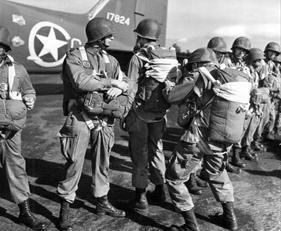 | 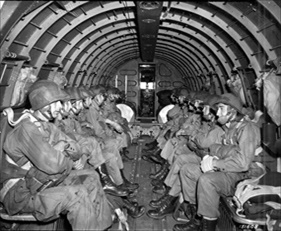 |
Above: The first U.S. airborne combat operations in history were conducted by 531 paratroopers of the 2nd Battalion, 509th Parachute Infantry Regiment as part of Operation Torch (November 8–16, 1942). Hardly anything was stellar about the PIR’s first combat performance. For starters the preflight briefings were lacking of good information. The 1‑way, 8‑hour, 1,100 straight-line air miles/1,770 kilometers flight from 2 southwestern English bases over neutral Spain to Western Algeria in 39 Douglas C‑47s of the 60th Troop Carrier Group was the longest mission of its kind in World War II. High winds and inclement weather scattered the 4 flight groups over hundreds of miles/kilometers. Only 32 arrived at their destination. The Royal Navy antiaircraft ship HMS Alynbank, equipped with a beacon that would begin sending radio signals from a position off the North African coast near Oran, Algeria’s second largest city and target of Torch’s Central Task Force, broadcast on the wrong frequency. A group of C‑47s landed on the desert coast to ask locals for directions to their drop zone (there were two, Tafaraoui and La Senia airfields that straddled Oran to the south). Paratroopers jumped from at least 9 C‑47s 35 miles/56 kilometers from Tafaraoui, which anyway was secured by ground troops that landed on the coast. Some aircraft and paratroopers were still scattered around North Africa by the time Oran fell on the morning of November 10. Five days later only about 300 paratroopers could be assembled for their next mission. Thus, the first U.S. Army airborne contribution to Operation Torch came to an anticlimactic end.
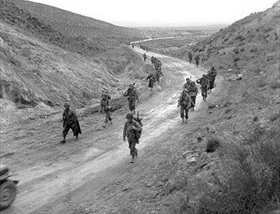 | 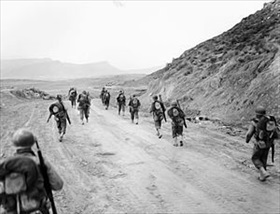 |
Above: In February 1943, elements of Rommel’s Afrika Korps attempted to seize Kasserine Pass, gateway to Allied-occupied Algeria, by a sudden, swift attack. A hodgepodge of U.S. and Free French units attempted to hold the pass. German infantry infiltrated around the defenders by climbing the heights on either side of the 2‑mile/3.2-kilometer-wide pass. Obsolescent but still potent Junkers Ju 87 Stuka dive-bombers, escorted by Messerschmitt Bf 109 fighters, entered the fray. On February 20, 1943, the pass was in German hands. As the Germans continued their effort to push the Americans back into Algeria on the morning of February 22, they ran into concentrated artillery fire. On February 23, the Americans cautiously advanced eastward to discover the Germans had withdrawn. Concerned that Montgomery’s British Eighth Army might attack him in the rear while he was moving west, Rommel abandoned the battlefield and retired to the east. (On March 9 Rommel was invalided home.) These photos show American units moving through the open pass.
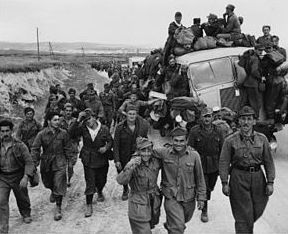 | 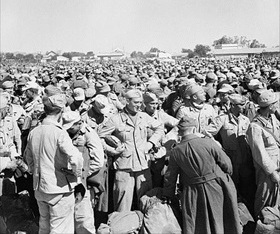 |
Left: In this photograph Italian prisoners of war are seen being herded out of Tunis as the British V Corps entered the capital on on May 7, 1943, the same day American armored and infantry divisions pushed the retreating Germans out of the port city of Bizerte in the north of the country. At 12:30 on May 13, 1 day after Italian dictator Benito Mussolini had named him Field Marshal, Giovanni Messe, the Governor of now Allied-occupied Libya, surrendered the remainder of the Italian First Army. (Messe avoided the fate of Col. Gen. Hans-Juergen von Arnim, Rommel’s capable but luckless successor—namely, prisoner of war in the U.S. state of Mississippi—by switching loyalties and fighting on the side of the Allies against Mussolini after the Italian armistice in September 1943.)
![]()
Right: With the fall of the Tunisian port cities of Tunis and Bizerte, 40 miles/64 kilometers apart, the pipe dream of a seaborne rescue of Axis forces, ready to fight another day, evaporated. In recognition thereof, Axis soldiers began surrendering in such large numbers that they clogged roads, impeding the Allies’ mopping-up operations. In the second week of May enemy prisoners totaled over 275,000, the majority of them German. Many POWs wound up at the Gromalia camp (shown here), 4 miles/6.4 kilometers outside Tunis. When Axis generals began surrendering on May 9, 1943, the 6‑month Tunisia Campaign entered its final days. Victory in Tunisia did not come cheaply. Of 70,000 Allied casualties, the U.S. Army lost 2,715 dead, 8,978 wounded, and 6,528 missing. At the same time, however, the Army gained thousands of seasoned officers, noncommissioned officers, and troops whose experience would prove decisive in subsequent campaigns. These seasoned soldiers would not have long to wait or far to go, for the next test was only 2 months and roughly 150 miles/241 kilometers away, the Italian island of Sicily and Operation Husky.
History Channel: U.S. Army Invades North Africa—Patton 360, Blood and Guts (May skip first minute)
![]()

 History buffs, there is good news! The Daily Chronicles of World War II is now available as an ebook for $4.99 on Amazon.com. Containing a year’s worth of dated entries from this website, the ebook brings the story of this tumultuous era to life in a compelling, authoritative, and succinct manner. Featuring inventive navigation aids, the ebook enables readers to instantly move forward or backward by month and date to different dated entries. Simple and elegant! Click
History buffs, there is good news! The Daily Chronicles of World War II is now available as an ebook for $4.99 on Amazon.com. Containing a year’s worth of dated entries from this website, the ebook brings the story of this tumultuous era to life in a compelling, authoritative, and succinct manner. Featuring inventive navigation aids, the ebook enables readers to instantly move forward or backward by month and date to different dated entries. Simple and elegant! Click 











